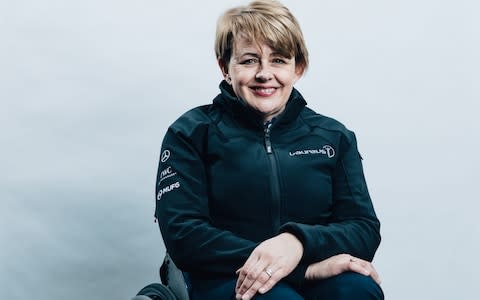Exclusive: Major sports bodies guilty of 'shocking' lack of women's representation at board level

International sports federations are facing calls to have their funding slashed if they fail to address "absolutely shocking" levels of female representation on their boards.
A major investigation by Telegraph Sport into gender diversity in international sports federations has revealed that women continue to be gravely under-represented at executive level.
Ten major federations were investigated: the International Olympic Committee, Fifa, the International Cricket Council, the International Basketball Federation, World Rugby, World Athletics, the International Golf Federation, the International Tennis Federation, the International Hockey Federation and the International Cycling Union.
The greatest gender imbalance was on the International Cricket Council, where just one of the 18 board members is female, but all the governing bodies were revealed to have fewer than 40 per cent of women on their board, while only three have at least 25 per cent female representation. None of the 10 boards is led by a woman.
Dame Katherine Grainger, chair of UK Sport, described the findings as “extremely concerning,” saying that “traditional structures in sport can be outdated and therefore not fit for purpose.”

Val Ackerman, a former representative on the International Basketball Federation (Fiba), called for the IOC to link funding to governance metrics, including the gender diversity on national boards.
“They could impose a gender minimum on international federation boards,” Ackerman said. “They could say your funding is going to be tied to progress in terms of the number of women you have on your governing boards and management teams - that would be a powerful motivator which could inspire change.”
Johanna Wood, the president of New Zealand Football and a representative on the Fifa Council, suggested that linking the funding of world football's governing body to the representation of women on national boards could help equalise the gender balance in leadership roles in the sport. Only six of the 37 members of the Fifa Council are women, while some member associations still have no female representation on their national boards at all.
“It's not a one size fits all solution but it needs to be explored,” Wood said. “You've got to actually say - how can we work with you to achieve this goal? Maybe some additional funding?”

The issue of board representation is becoming an increasing concern for governing bodies, and several European sports leaders are meeting in Helsinki on Tuesday at a forum co-organised by the IOC, the European Olympic Committee and Finland’s National Olympic Committee to discuss the issue.
Telegraph Sport's investigation revealed little change in most sports - with rugby a notable exception - since 2016, when Women on Boards conducted a previous survey.
The overall gender representation figures across international boards were called “frightening” by Joanna Adams, the former chief executive of Netball England who is now chief commercial officer at the London Legacy Development Corporation.
“The statistics are absolutely shocking," she said. “It matters greatly because you have to have diverse opinions,” said Adams, calling on sports bodies to be more proactive in addressing representation.
“International federations have got to write long-term strategies that change their governance structures. It's not going to be an overnight change I wouldn’t imagine.”

Some federations have changed the nature of their boards to improve representation in recent years, with rugby a stand-out example. In 2017 World Rugby mandated that all member associations with representatives on the council could add an additional member if they were a woman. Since then, the female representation on the council has risen from zero, out of 32, to 18 out of 50.
Of all the boards surveyed, the International Hockey Federation had the highest female representation, with 37.5 per cent.
“I think there’s a connection that the women players are inspired by what we are doing at the board level,” said Marijke Fleuren, an International Hockey Federation executive board member.
Last year, the IOC approved the 25 recommendations made by its Gender Equality Review Project, which was aimed at increasing gender diversity.
While only three of the 15 members on the IOC’s executive board are female, 45 per cent of those on IOC commissions are women, a figure that has doubled since 2013.

In its governance reforms in 2016, Fifa mandated that each of the six confederations must have at least one woman as a representative on the Fifa Council. That has been born out, but there are no female representatives on the Council besides those six guaranteed berths.
Fifa insist they are "strongly committed to further increasing the representation of women”, and have set a target of having women make up at least one-third of all committee members by 2022, and for all 211 member associations to have at least one woman present on their executive committees by 2026.
Fatma Samoura was appointed as Fifa's first ever female General Secretary in 2016, and 43 per cent of all employees are women - though there are a far lower proportion in the biggest leadership roles.
The risks of failing to rebalance gender representation at executive level were spelled out by multiple Paralympic gold medalist Baroness Tanni Grey-Thompson.
“It’s quite stark when you see the numbers as well as the percentages,” she said. “If business understands the need for diversity then sport should recognise it as well.
“All international federations should be looking at equal representation because it is not just about who plays, but who watches and any sport needs to reach the widest market possible.”
Case Study: the International Cricket Council

Of all the international sports federations surveyed by Telegraph Sport, none had less gender diversity than cricket. Only one of the International Cricket Council’s 18 board members are female.
The figure was zero until 2017, when the ICC changed its constitution to add an independent female director to the board - Indra Nooyi, the former chief executive of PepsiCo. But the ICC’s chairman, chief executive and all 15 national representatives - 12 from Test-playing nations and three from Associate nations - all remain male.
The ICC appears to be stuck in a bind when it comes to gender diversity on its board. It can either wait for change to come via member associations - likely to be a torturous process. Alternatively, it can be altogether more radical, mirroring what has happened in rugby, at the risk of creating a board that is too large to act decisively.
An ongoing governance review into the ICC, which launched in October, and is chaired by Cricket Australia Chairman Earl Eddings, will consider all aspects of the current governance model, and what is best practice.
The review may yet recommend a significant restructuring of the board - perhaps reducing the number of national representatives in favour of more independents - and could advocate that the organisation take more radical steps to introduce more diversity on its board. It may also explore guaranteeing a certain amount of female representation on some crucial ICC committees.
Case Study: World Rugby

Two years ago, World Rugby had the distinction - in a particularly crowded field - of having the worst gender imbalance of any sporting federation. Out of 32 representatives on World Rugby’s council, not a single one was female.
“It's difficult to claim that you’re inclusive if you don’t have the right balance of gender in your board,” reflects Brett Gosper, the chief executive of World Rugby. “It was embarrassing.”
Embarrassment was the catalyst for radical change. In 2017, a governance review at World Rugby advocated that all member nations with representatives on the council should be allowed to add one member - which meant tier one nations like England going from two to three - but only on the provision that the additional member was a woman.
In the often arcane world of sports governance, this amounted to one of the most profound shifts ever seen. Today, 18 out of World Rugby’s 50 members are female - though the executive committee, which retains some important powers, only has one woman out of 11 members.
“It was quite a dramatic change,” Gosper explains. “Rugby recognised it was really late in getting together our act in this sphere. This gave us a turbocharged boost to put representation in the right proportion.”
The change in the boardroom has led to wider change. “In all areas of women's rugby, it accelerated hugely the urgency and the seizing of that opportunity. I don’t think that would have followed through with as much gusto if women had not been involved,” Gosper says. The equal branding of the Rugby World Cups for both genders is one manifestation of this change. But the impact of fresh perspectives and cognitive diversity, insiders report, has not been restricted to the women’s game alone.
“For a dramatic change to governance, it was met with very little resistance in what you'd think would be a conservative, male sport,” Gosper reflects. “It was embraced, not greeted with resistance, which was a sign it was going to work. It's certainly been a very smooth transition - and I guess why wouldn’t it be?”
The transformation of World Rugby’s council “has been a game changer for having more diversity at the highest level of decision making,” says Ada Milby, a council representative for Asia Rugby. It “sets the benchmark for other sporting codes to follow suit by using creative and out of the box thinking.”
